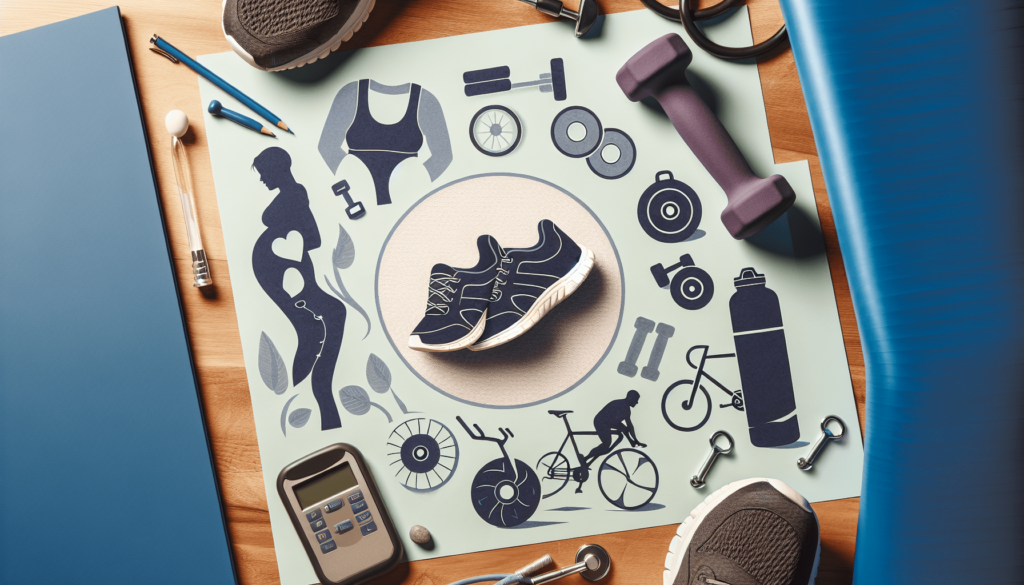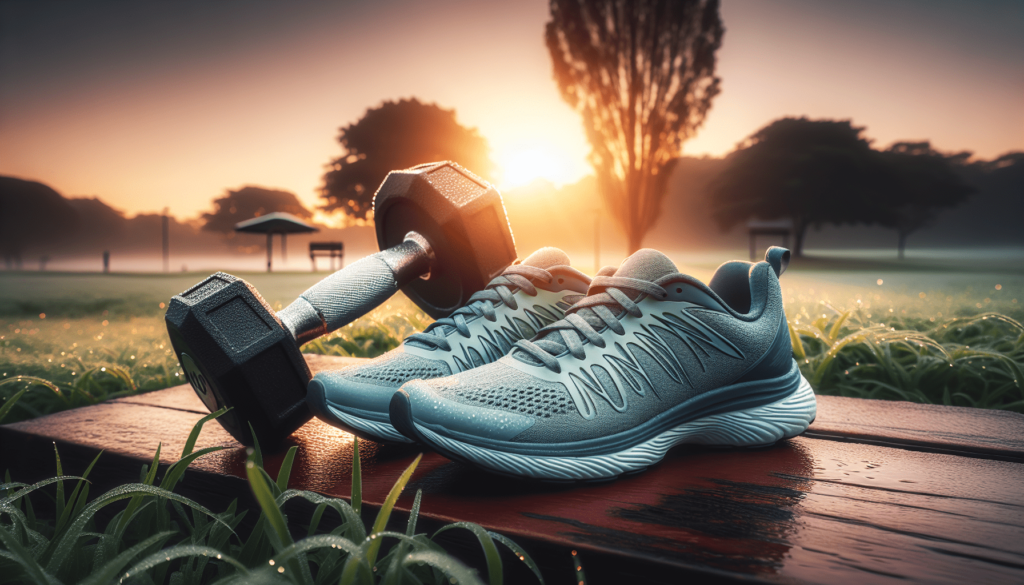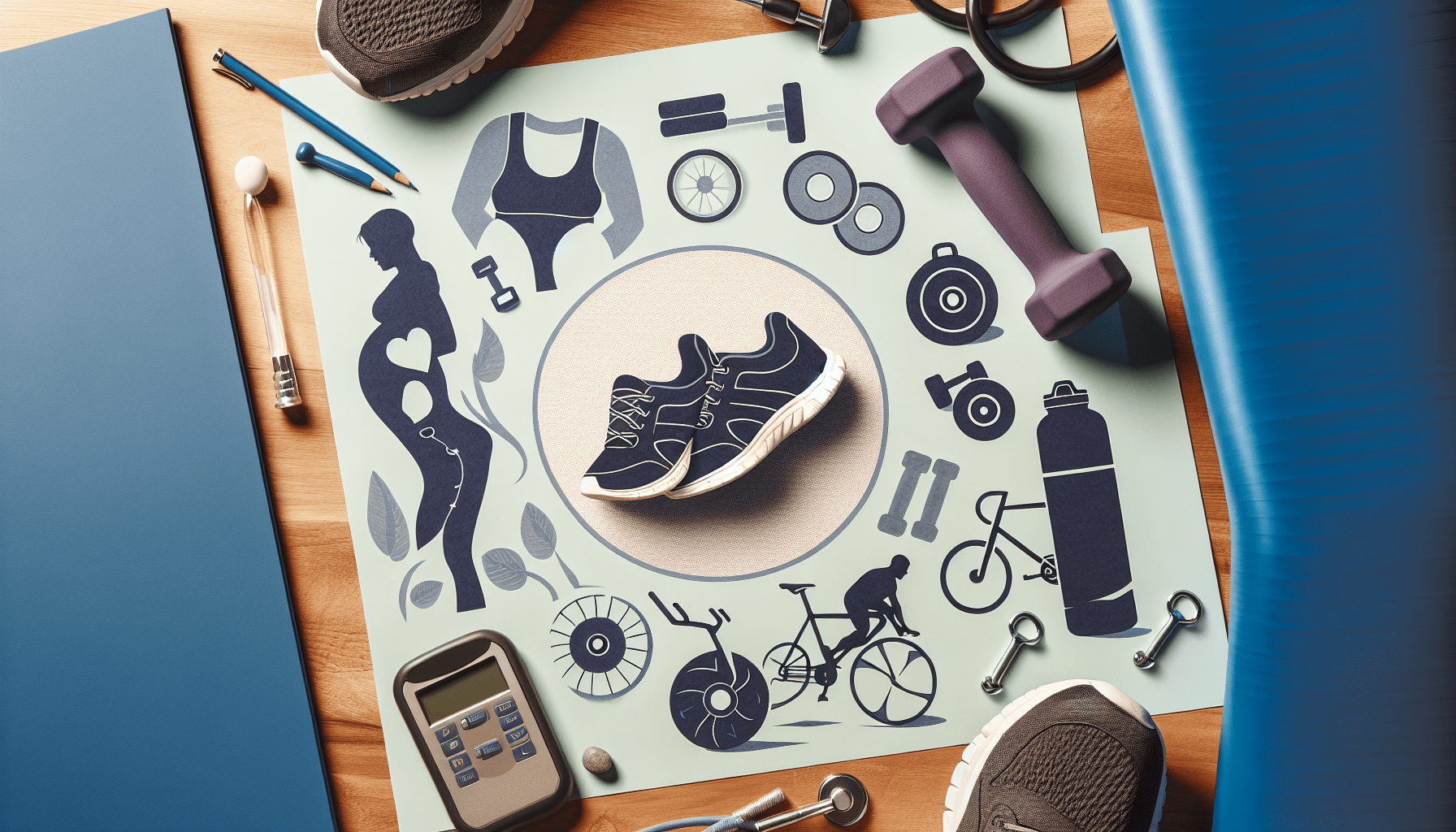As an Amazon Associate I earn from qualifying purchases.
Congratulations on the arrival of your precious bundle of joy! Now that your little one is here, it’s only natural that you want to take care of yourself as well. That’s where postpartum fitness comes in. In this article, we will explore the importance of postpartum fitness and how it can help you regain your strength, boost your energy levels, and promote overall well-being after childbirth. Whether you’re a new mom or have several children, this is your ultimate guide to reclaiming your fitness journey and embracing a healthy lifestyle as you navigate through the beautiful adventure of motherhood.

Understanding Postpartum Fitness
Definition of postpartum fitness
Postpartum fitness refers to the physical activity and exercises that new mothers engage in after giving birth to improve their overall health and well-being. It involves focusing on strengthening and toning muscles, improving cardiovascular endurance, and promoting overall body recovery during the postpartum period.
Importance of postpartum fitness
Engaging in regular postpartum fitness activities is crucial for several reasons. Firstly, it aids in the recovery process, helping new moms regain their strength and energy after childbirth. It also helps in managing postpartum mood disorders such as postpartum depression and anxiety, which are common during this period.
Furthermore, postpartum fitness plays a pivotal role in improving cardiovascular health, preventing chronic diseases, and promoting weight loss. It can also enhance body image and self-acceptance, boosting self-confidence and self-esteem during this transformative phase of motherhood.
Challenges faced by new mothers in maintaining fitness
New mothers face several challenges when trying to maintain fitness after childbirth. Time constraints and lack of energy are two major obstacles. The demands of caring for a newborn can be overwhelming, leaving little time and energy for exercise. Additionally, sleep deprivation and fatigue can make it difficult to find motivation for physical activity.
Mom guilt is another challenge commonly faced by new mothers. Balancing the responsibilities of caring for a baby and taking time for self-care can be a delicate balancing act, often leading to feelings of guilt. Social pressures and unrealistic expectations regarding body image can also make it challenging for new mothers to prioritize their own fitness and recovery.
Benefits of postpartum fitness
Engaging in postpartum fitness activities offers numerous benefits for new mothers. Aside from aiding in physical recovery, regular exercise can significantly improve mental well-being. It promotes the release of endorphins, which are natural mood boosters, and helps reduce the risk of postpartum depression and anxiety.
Postpartum fitness also improves cardiovascular health, strengthens muscles, and enhances flexibility and endurance, making daily tasks easier to handle. It can also assist in weight loss and toning, helping women regain their pre-pregnancy bodies. Additionally, participating in fitness activities can create a sense of community and support among new mothers, fostering social connections and reducing feelings of isolation.
Returning to Exercise After Childbirth
Consulting with a healthcare provider
Before starting any postpartum exercise routine, it is essential to consult with a healthcare provider. They can assess the mother’s physical well-being and provide guidance tailored to her specific needs. This step is crucial, especially for women who had a complicated delivery or medical conditions during pregnancy.
Healthcare providers can help in determining the right time to begin exercising, ensuring the body has adequately healed before engaging in more strenuous activities. They can also provide advice on how to gradually increase the intensity and duration of workouts.
Understanding the healing process
After childbirth, the body goes through significant physical changes, both externally and internally. It is vital to understand the healing process and give the body ample time to recover. This includes allowing the muscles and tissues to heal, the uterus to shrink back to its pre-pregnancy size, and hormonal levels to stabilize.
Postpartum bleeding, known as lochia, is common during the healing process. It is crucial to listen to the body and avoid activities that could potentially hinder the healing process or cause complications.
Timing for starting exercise
The optimal time to start exercising after childbirth varies for each woman and is best determined in consultation with a healthcare provider. In general, most women can begin gentle exercises, such as walking, once they feel comfortable and have received medical clearance.
It is essential to start slowly and gradually increase the intensity and duration of workouts. Pushing oneself too hard too quickly can lead to injury or slow down the healing process. Patience and listening to one’s body are key during this phase.
Types of postpartum exercises
There is a wide range of postpartum exercises that new mothers can incorporate into their fitness routine. It is crucial to choose exercises that are safe, effective, and suitable for the individual’s fitness level and comfort.
Pelvic floor exercises are particularly important in postpartum fitness as they help strengthen the muscles that support the pelvic organs. These exercises, such as Kegels, can aid in improving bladder control, preventing pelvic organ prolapse, and enhancing sexual health.
Core strengthening exercises, such as modified planks and pelvic tilts, can help restore abdominal strength and improve posture. Low-impact exercises like swimming, stationary cycling, and prenatal yoga are gentle on the joints and provide cardiovascular benefits without putting excessive strain on the body.
Yoga and Pilates are excellent options for postpartum recovery as they focus on core strength, flexibility, and relaxation. Strength training and resistance exercises, using bodyweight or light weights, can help build muscle tone and improve overall strength.
Safe and Effective Postpartum Exercises
Pelvic floor exercises
Pelvic floor exercises, also known as Kegels, are crucial for postpartum recovery. These exercises target the muscles that support the pelvic organs and play a pivotal role in bladder and bowel control, sexual function, and core stability.
To perform a Kegel exercise, start by identifying the pelvic floor muscles. Imagine stopping the flow of urine midstream or contracting the muscles that would prevent the passing of gas. Slowly contract and lift these muscles for a few seconds, then release and relax. Repeat this exercise several times throughout the day to strengthen the pelvic floor.
Core strengthening exercises
Postpartum core strengthening exercises focus on rebuilding strength in the abdominal muscles, particularly the pelvic floor and deep abdominal muscles. These exercises are essential for improving posture, preventing back pain, and regaining a flat and toned abdomen.
One effective core exercise is the modified plank. Start by positioning yourself on your hands and knees, aligning your wrists with your shoulders and your knees with your hips. Engage your core by pulling your navel towards your spine, then lift your knees so that your body forms a straight line from your head to your heels. Hold this position for a few seconds while maintaining a strong core, then lower your knees back down. Repeat this exercise several times, gradually increasing the duration of each hold.
Low-impact exercises
Low-impact exercises are ideal for postpartum fitness as they minimize stress on the joints while still providing cardiovascular benefits. Walking is a great low-impact exercise that can be easily incorporated into daily routines. Start with short walks and gradually increase the distance as stamina improves.
Swimming and stationary cycling are also excellent options for low-impact workouts. They provide the benefits of cardiovascular exercise without placing excessive strain on the body. Prenatal yoga, specifically designed for pregnant and postpartum women, incorporates gentle stretches and poses that promote relaxation and flexibility.
Yoga and Pilates for postpartum recovery
Yoga and Pilates are popular choices for postpartum recovery due to their focus on core strength, flexibility, and relaxation. These practices can help new mothers reconnect with their bodies, improve posture, and relieve stress.
Yoga poses that target the pelvic floor, such as cat-cow and bridge pose, can be beneficial for strengthening the core and pelvic muscles. Additionally, deep breathing techniques practiced in yoga and Pilates can help promote relaxation and reduce anxiety.
It is important to choose postpartum-specific classes or modify poses as necessary to ensure they align with the body’s healing process and comfort level. Consulting with a qualified instructor is highly recommended.
Strength training and resistance exercises
Strength training and resistance exercises are essential for rebuilding muscle tone and overall strength. These exercises can aid in toning the body, boosting metabolism, and increasing bone density.
Using bodyweight exercises, such as squats, lunges, and push-ups, can provide an effective strength training workout. As strength improves, resistance bands or light weights can be incorporated to provide additional resistance.
It is important to start with light weights and gradually progress to heavier ones as strength and endurance increase. Proper form and technique are crucial to ensure safety and effectiveness. Consulting with a qualified fitness professional can provide guidance and personalized recommendations based on individual needs and capabilities.

Addressing Common Concerns and Considerations
Diastasis recti and exercises to avoid
Diastasis recti is a common condition that occurs when the abdominal muscles separate during pregnancy. It can cause a bulge or pooch in the midsection, and certain exercises can exacerbate the condition.
To avoid worsening diastasis recti, it is essential to avoid exercises that put excessive strain on the abdominal muscles, such as traditional crunches or sit-ups. Instead, focus on diastasis recti-specific exercises, such as modified planks and pelvic tilts, that engage the deep core muscles without placing excessive pressure on the separating abdominal muscles.
Dealing with mom guilt and time constraints
Many new mothers struggle with feelings of guilt when prioritizing their own fitness and self-care needs. It is important to remember that taking care of oneself is essential for overall well-being and can benefit both the mother and the baby.
To overcome mom guilt, it can be helpful to involve the baby in exercise routines. Going for stroller walks or participating in mommy-and-me fitness classes can allow new moms to incorporate exercise while bonding with their little ones.
Additionally, carving out dedicated time for self-care and fitness is crucial. This may require enlisting the help of a partner, family member, or trusted caregiver to provide support and childcare, allowing the mother to prioritize herself without guilt.
Managing fatigue and sleep deprivation
Fatigue and sleep deprivation are common challenges faced by new mothers, making it difficult to find motivation for exercise. It is important to listen to the body and rest when needed, especially during the early weeks following childbirth.
Incorporating short bursts of physical activity throughout the day can be more manageable and less overwhelming than trying to do a continuous workout session. Finding small windows of time, such as during nap times or while the baby is engaged in independent play, can allow for brief exercise sessions.
It is crucial to prioritize sleep and rest to aid in overall recovery. Napping when the baby sleeps and seeking support from loved ones or a postpartum doula can provide valuable opportunities for new mothers to recharge and regain energy.
Breastfeeding and exercise
Many women have concerns about breastfeeding and its potential impact on exercise. It is generally safe to exercise while breastfeeding, and exercise does not affect the quantity or quality of breast milk.
It is important to ensure adequate hydration before, during, and after exercise, as breastfeeding can increase fluid needs. Wearing supportive bras or nursing sports bras can provide added comfort and help prevent discomfort while exercising.
If there are concerns or specific questions about breastfeeding and exercise, it is advisable to consult with a lactation consultant or healthcare provider for personalized guidance.
Body image and self-acceptance
Body image and self-acceptance are significant considerations for new mothers. It is essential to remember that each body’s postpartum journey is unique, and comparing oneself to others or societal ideals can be detrimental to mental well-being.
Focusing on the achievements and progress made during the postpartum fitness journey, rather than solely on physical appearance, can promote a positive mindset. Celebrating small victories, such as increased strength or improved endurance, can boost self-confidence and foster a healthy body image.
Practicing self-compassion and kindness towards oneself is crucial during this period of physical and emotional adjustment. Surrounding oneself with supportive and positive influences, whether online or in-person, can help create a nurturing environment for self-acceptance and body positivity.
Creating a Postpartum Fitness Plan
Setting realistic goals
Setting realistic goals is crucial when creating a postpartum fitness plan. It is important to remember that the body has gone through significant changes during pregnancy and childbirth, and it takes time to regain strength and endurance.
Instead of focusing solely on weight loss or a specific physical outcome, consider setting goals that prioritize overall well-being and self-care. Examples of realistic goals include improving cardiovascular endurance, practicing self-care for a set amount of time each day, or gradually increasing the frequency of workouts.
By setting attainable goals, new mothers can maintain motivation and track progress, fostering a sense of achievement and satisfaction along the postpartum fitness journey.
Finding time and support
Finding time for exercise can be challenging for new mothers, but with planning and support, it is possible to incorporate fitness into daily routines. Identifying pockets of time throughout the day, such as early mornings or evenings when the baby is asleep, can provide opportunities for exercise.
Enlisting the support of a partner, family member, or trusted caregiver can also make a significant difference. Having someone to help with childcare or household responsibilities can free up time for self-care and exercise.
Additionally, exploring options for online workouts or postpartum fitness classes that offer childcare can provide a solution for new mothers seeking structured exercise programs while ensuring the baby is taken care of.
Gradual progression and modifications
Postpartum fitness should be approached with a gradual progression mindset. It is important to start with low-impact activities and slowly increase the intensity, duration, and frequency of workouts as the body becomes stronger and more conditioned.
Modifications to exercises may be necessary to accommodate the healing process and individual needs. For example, opting for gentler versions of certain movements or using lighter weights can help prevent strains or injuries.
Listening to the body’s cues and acknowledging limitations is essential. Pushing oneself too hard can hinder the recovery process and increase the risk of injury. Consulting with a qualified fitness professional can provide guidance on modifications and appropriate progressions.
Incorporating other forms of physical activity
Physical activity does not have to be limited to traditional workouts. Incorporating other forms of movement and activity into daily routines can help increase overall physical activity levels.
Activities such as taking the stairs instead of the elevator, parking farther away from destinations to incorporate more walking, or engaging in household chores that require physical effort can all contribute to an active lifestyle.
Additionally, involving the baby in activities such as babywearing walks, dancing, or playing together can provide an opportunity for bonding and physical activity simultaneously.
Tracking progress and celebrating achievements
Tracking progress and celebrating achievements are important aspects of a postpartum fitness plan. Keeping a journal or using a fitness app to record workouts, mood, energy levels, and measurements can provide a tangible way to assess and track progress.
Celebrating achievements, whether big or small, is crucial for maintaining motivation and fostering a positive mindset. Reaching a milestone, such as completing a certain number of workouts in a week or noticing improvements in strength and endurance, should be acknowledged and celebrated.
Recognizing and celebrating progress helps create a sense of accomplishment and provides motivation to continue on the postpartum fitness journey.
Nutrition and Hydration for Postpartum Recovery
Importance of balanced nutrition
Balanced nutrition plays a vital role in postpartum recovery and overall well-being. Providing the body with the necessary nutrients supports healing, boosts energy levels, and aids in weight loss.
A diet rich in fruits, vegetables, whole grains, lean proteins, and healthy fats is recommended. Including a variety of nutrient-dense foods such as leafy greens, berries, lean meats, legumes, and nuts can help meet nutritional needs and promote optimal recovery.
Postpartum dietary recommendations
During the postpartum period, it is important to prioritize nourishing foods that support healing and overall health. Adequate consumption of protein is essential for muscle repair and recovery. Incorporating sources of lean protein such as poultry, fish, tofu, and legumes into meals and snacks is recommended.
Iron-rich foods, such as lean meats, dark leafy greens, and fortified grains, are important for replenishing iron stores depleted during pregnancy and childbirth. Calcium-rich foods like yogurt, cheese, and leafy greens are crucial for supporting bone health, especially for breastfeeding mothers.
Eating small, frequent meals throughout the day can help stabilize blood sugar levels and maintain energy levels. Including a variety of fruits and vegetables in the diet provides essential vitamins, minerals, and antioxidants to support overall health and recovery.
Hydration tips for breastfeeding mothers
Proper hydration is vital for breastfeeding mothers as it supports milk production and helps prevent dehydration. Drinking enough fluids, especially water, throughout the day is essential.
Aim to drink at least eight glasses of water per day, or more if engaging in physical activity or in hot weather. Keeping a water bottle nearby as a reminder to drink regularly can be helpful. Other hydrating options include herbal teas, decaffeinated drinks, and naturally flavored water.
Monitoring urine color is a useful indicator of hydration status. Pale or light yellow urine generally indicates adequate hydration, while darker urine may suggest the need for increased fluid intake.
Fueling the body for exercise
Fueling the body with proper nutrition before and after exercise is crucial for optimal performance and recovery. Prior to a workout, consuming a combination of carbohydrates and protein can provide the necessary energy and facilitate muscle repair.
Healthy pre-workout snack options include a banana and nut butter, Greek yogurt with fruit, or a small smoothie containing fruits and protein powder.
After exercise, it is important to replenish energy stores and aid in muscle recovery. Consuming a post-workout snack or meal that includes a mix of carbohydrates and protein within 30-60 minutes of completing the workout is recommended. Examples of post-workout snacks include a protein shake, a turkey and vegetable wrap, or a small serving of Greek yogurt with granola.
Ensuring adequate nutrition and hydration before and after exercise helps support the body’s recovery process and enhances overall postpartum fitness outcomes.
Mental Well-being and Self-Care
Addressing postpartum mood disorders
Postpartum mood disorders, such as postpartum depression and anxiety, are common and can greatly impact a mother’s mental well-being. It is essential to recognize the signs and symptoms of these conditions and seek appropriate support and treatment.
Engaging in regular exercise has been shown to have a positive impact on mental health, helping reduce the risk and severity of postpartum mood disorders. Exercise promotes the release of endorphins, which are natural mood boosters, and can help reduce stress and anxiety.
However, it is important to recognize that exercise alone may not be enough to manage postpartum mood disorders, and professional help may be needed. Seeking support from healthcare providers, therapists, support groups, and loved ones can provide much-needed understanding, guidance, and empathy during this challenging time.
Establishing self-care routines
Prioritizing self-care is essential for new mothers in maintaining mental well-being and overall health. Taking time for oneself, even in small increments, can make a significant difference in managing stress and promoting relaxation.
Establishing self-care routines can involve activities such as taking a warm bath, practicing mindfulness or meditation, engaging in hobbies or activities that bring joy, or simply taking a few minutes each day for deep breathing or relaxation exercises.
Incorporating self-care into the daily routine sends a message of self-love and self-compassion, reminding new mothers of the importance of taking care of themselves while caring for their little ones.
Finding support and community
Building a support network and finding a community of other new mothers can greatly contribute to mental well-being and postpartum recovery. Sharing experiences, concerns, and triumphs with others who are going through similar challenges can provide validation, support, and a sense of belonging.
Joining local or online support groups specifically designed for postpartum mothers can be beneficial. These groups offer a platform for sharing advice, information, and emotional support. Hearing others’ stories and realizing that one is not alone in their experiences can be empowering and reassuring.
Additionally, involving partners, family members, or friends in the postpartum journey can provide additional support and understanding. Communicating needs and seeking help when needed is crucial for maintaining mental well-being and feeling supported.
Incorporating relaxation techniques
Incorporating relaxation techniques into daily routines can help reduce stress, promote relaxation, and manage anxiety. Deep breathing exercises, meditation, and gentle stretching are effective relaxation techniques that can be easily integrated into the day.
Deep breathing exercises involve taking slow, deliberate breaths, allowing the body to relax and focus on the present moment. This can be done while breastfeeding, during a short break, or before bedtime to promote relaxation and calmness.
Meditation, even for a few minutes a day, can help clear the mind, reduce anxiety, and enhance overall well-being. Online resources, apps, and guided meditation videos specifically for postpartum mothers can provide guidance and support in establishing a regular meditation practice.
Gentle stretching or gentle yoga poses can help release tension in the body, improve flexibility, and promote relaxation. Incorporating these activities into the daily routine can provide a dedicated time for self-care and facilitate a sense of calm.
The role of exercise in mental well-being
Exercise plays a crucial role in supporting mental well-being during the postpartum period. Physical activity promotes the release of endorphins, which are natural mood boosters, and can help reduce symptoms of anxiety and depression.
Engaging in regular exercise provides an opportunity for new mothers to focus on themselves and take a break from the demands of caring for a baby. It can provide a sense of accomplishment, boost self-confidence, and improve body image.
Additionally, exercise can have social benefits. Participating in postpartum fitness classes or joining online communities allows new mothers to connect with others who are going through similar experiences. This sense of community and support can help combat feelings of isolation and loneliness.
Overall, exercise is a powerful tool for maintaining mental well-being, improving mood, and fostering a positive mindset during the postpartum period.
Overcoming Barriers to Postpartum Fitness
Time management and scheduling
Time management is a common barrier to postpartum fitness. The demands of caring for a newborn can make it challenging to find time for exercise. However, with proper planning and prioritization, it is possible to carve out time for physical activity.
Creating a schedule or using a planner to allocate dedicated time for exercise can help ensure it becomes a daily priority. This may involve waking up earlier, utilizing nap times, or enlisting the help of a partner or caregiver.
Maximizing efficiency by incorporating exercise into daily routines, such as combining physical activity with household chores or baby care, can also help overcome time constraints.
Lack of motivation and consistency
Lack of motivation and consistency can be significant barriers to postpartum fitness. It is normal for motivation levels to fluctuate during this phase of motherhood, making it important to find strategies that help maintain consistency.
Setting realistic goals and focusing on small, achievable milestones can provide motivation along the way. Consistency is key, even if it means starting with short, frequent workouts and gradually increasing the intensity and duration over time.
Mixing up the exercise routine to keep things fresh and interesting can also help combat boredom and increase motivation. Trying new activities, signing up for group classes, or exploring online workout platforms can provide variety and prevent monotony.
Accountability partners, whether a friend, partner, or online community, can also help provide motivation and support, keeping new mothers committed to their fitness goals. Sharing progress, setbacks, and achievements with others can foster a sense of accountability and encouragement.
Childcare and exercising with your baby
Childcare can be a challenge when it comes to finding time for exercise. However, involving the baby in workouts can be a practical and enjoyable solution.
Using a baby carrier or stroller while going for walks or jogs allows new mothers to incorporate exercise while spending quality time with their baby. Babywearing workouts, such as strength training or yoga, provide opportunities for increasing strength and bonding simultaneously.
Additionally, exploring postnatal fitness classes or online programs that offer childcare options can provide a dedicated time and space for exercise while ensuring the baby is well-cared for. These classes often include activities that involve the baby, promoting interaction and bonding between mother and child.
Remembering that exercise is not solely about intense workouts but also about incorporating movement into daily routines with the baby can help overcome childcare challenges and maintain consistency in postpartum fitness.
Adapting to physical changes
The physical changes that occur during pregnancy and postpartum can present unique challenges. Adapting to these changes and embracing the body’s new normal is crucial for fostering a positive mindset and promoting body acceptance.
Recognizing that the body has undergone significant transformations and that recovery takes time is essential. Patience and self-compassion are key when adapting to physical changes. It is important to remember that the focus should be on overall health and well-being rather than solely on achieving a specific physique.
Modifying exercises as needed to accommodate physical changes or discomfort is important for preventing injuries. Working with qualified fitness professionals or seeking guidance from healthcare providers can provide valuable insights and safe modifications tailored to individual needs.
Overcoming societal pressures and perceptions
Societal pressures and perceptions regarding postpartum bodies can greatly impact a mother’s self-confidence and body image. It is important to remember that every body is unique, and comparison to societal standards is neither realistic nor healthy.
Developing a positive mindset and embracing the body’s strengths and capabilities is crucial. Surrounding oneself with positive influences, both online and offline, can help challenge societal perceptions and create a supportive environment.
Recognizing and celebrating the body’s achievements and progress, no matter how small, is essential. Focusing on overall well-being, self-acceptance, and self-care rather than solely physical appearance can help overcome societal pressures and promote a healthy postpartum fitness journey.
Seeking Professional Guidance
Working with a postpartum fitness specialist
Working with a postpartum fitness specialist can provide personalized guidance and support tailored to individual needs. These professionals are trained in addressing the unique concerns and considerations of postpartum women, ensuring safe and effective exercise programs.
A postpartum fitness specialist can help in developing a customized fitness plan that takes into account factors such as individual goals, physical capabilities, and any specific postpartum conditions or concerns. They can provide expert guidance on exercises, modifications, progressions, and recovery timelines.
Consulting with a postpartum fitness specialist can be especially beneficial for women who had medical complications during pregnancy or childbirth. These specialists can collaborate with healthcare providers, ensuring a well-rounded approach to postpartum recovery.
Joining postnatal fitness classes or programs
Joining postnatal fitness classes or programs specifically designed for postpartum women can provide numerous benefits. These classes often offer a supportive and inclusive environment, allowing new mothers to connect with others going through similar experiences.
Postnatal fitness classes typically focus on exercises that are safe and effective for postpartum recovery. Qualified instructors can guide participants in proper form and technique, ensuring exercises align with individual needs and capabilities.
These classes may also incorporate activities that involve the baby, promoting bonding and interaction while still prioritizing exercise. Joining these classes provides an opportunity for socialization, support, and community building.
Online resources and virtual support
Online resources and virtual support can be valuable tools for postpartum fitness. There are numerous websites, blogs, and social media platforms dedicated to providing information, guidance, and inspiration for new mothers.
Online workout platforms and fitness apps offer a wide range of postpartum-specific exercises and programs that can be accessed from the comfort of home. These tools often provide modifications and progressions suitable for various fitness levels.
Virtual support groups and online communities can provide a sense of connection and support, especially for those who may not have access to local resources. Sharing experiences, seeking advice, and celebrating achievements with others in similar situations can be empowering and motivating.
When utilizing online resources, it is important to ensure that the information provided is reliable and evidence-based. Consulting with healthcare providers or qualified fitness professionals can help in determining the credibility of these resources.
Importance of listening to your body
Throughout the postpartum fitness journey, it is essential to listen to the body and honor its needs. Each woman’s body is unique, and what feels comfortable or challenging may differ from person to person.
Paying attention to how the body feels during and after exercise is important. If an exercise causes pain, discomfort, or other adverse symptoms, it is crucial to modify or avoid it and seek guidance from a healthcare provider or qualified fitness professional.
Listening to the body’s cues for rest and recovery is equally important. Rest days are necessary for allowing the body to heal and recharge. Ignoring signs of fatigue or overexertion can lead to injury or hinder the recovery process.
Understanding and respecting the body’s limitations and capabilities is key to preventing injury and maximizing the benefits of postpartum fitness.
The role of professional guidance in preventing injuries
Professional guidance is instrumental in preventing injuries during postpartum fitness. Working with qualified fitness professionals, such as postpartum fitness specialists or certified personal trainers with expertise in postpartum exercise, can significantly reduce the risk of injury.
These professionals have the knowledge and experience to assess individual needs, provide guidance on proper form and technique, and recommend appropriate exercises based on the body’s healing progress and capabilities.
Postpartum fitness specialists can identify and address any postpartum conditions that may potentially be aggravated by certain exercises, ensuring safe and effective workouts. They can guide individuals through modifications and progressions, minimizing the risk of strain or injury.
Professional guidance also serves as a source of motivation, accountability, and support. These professionals can provide encouragement and reassurance along the postpartum fitness journey, helping individuals stay on track and achieve their goals safely.
Celebrating Postpartum Fitness Success Stories
Inspiring stories of postpartum fitness journeys
Sharing inspiring stories of postpartum fitness journeys can motivate and encourage new mothers. Reading or hearing about the experiences of other women who have overcome challenges, achieved their goals, and improved their overall health can provide inspiration during the postpartum period.
Connecting with real-life success stories, whether through online platforms, social media, or personal networks, can help new mothers realize that they are not alone in their struggles and aspirations. These stories highlight the resilience, dedication, and triumphs of women who have navigated the postpartum fitness journey.
Empowering and supporting other new moms
Empowering and supporting other new moms in their postpartum fitness journeys can create a positive and inclusive community. Sharing personal experiences, offering encouragement, and providing advice or resources can make a significant impact on someone else’s wellness journey.
Support can be provided through online platforms, local fitness groups, or mom-specific support networks. Together, new mothers can uplift and inspire one another to prioritize their well-being and embrace the postpartum fitness journey.
Creating a positive and inclusive postpartum fitness community
Creating a positive and inclusive postpartum fitness community is essential for fostering support, understanding, and encouragement. This community can provide a safe space for new mothers to share their experiences, seek advice, and celebrate each other’s achievements.
Inclusive communities strive to embrace and celebrate the diversity of postpartum experiences, body sizes, physical abilities, and fitness levels. By promoting body positivity and accepting all body types, these communities help combat societal pressures and promote a healthy mindset.
Creating a positive and inclusive postpartum fitness community involves actively engaging with others, sharing resources, and promoting kindness and support. An inclusive community uplifts and empowers new mothers, creating an environment that encourages healthy lifestyles, body acceptance, and overall well-being.
Highlighting the diverse experiences and achievements
Highlighting the diverse experiences and achievements within the postpartum fitness community is important for breaking societal norms and promoting inclusivity. Celebrating stories and accomplishments from women of different backgrounds, body types, and fitness levels helps challenge the notion of a one-size-fits-all approach to postpartum fitness.
By highlighting diverse experiences, these stories help new mothers feel seen, represented, and encouraged. They provide a broader perspective on what is possible during the postpartum period and foster an environment where all women feel welcome and supported.
Spreading awareness of the importance of postpartum fitness
Spreading awareness of the importance of postpartum fitness is essential for promoting the overall health and well-being of new mothers. By sharing information, resources, and success stories, awareness can be raised about the benefits of postpartum fitness for physical, mental, and emotional health.
Publicizing the advantages of postpartum fitness through various channels, such as social media, local health organizations, and healthcare provider networks, helps educate and empower new mothers. This awareness encourages them to prioritize their well-being, seek appropriate support, and engage in safe and effective postpartum fitness practices.
By spreading awareness, postpartum fitness can be viewed as an integral part of the overall postpartum experience, contributing to healthier and happier moms.
Amazon and the Amazon logo are trademarks of Amazon.com, Inc, or its affiliates.










